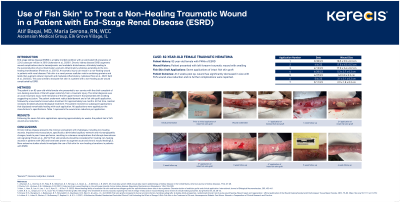Case Series/Study
(CS-019) Use of Fish Skin to Treat a Non-Healing Traumatic Wound in a Patient with End-Stage Renal Disease (ESRD)

End-stage kidney disease (ESRD) is a highly morbid condition with an estimated US prevalence of 2,242 cases per million in 2018 (Johansen et al., 2020)1. Chronic kidney disease (CKD) augments wound complications due to hemodynamic and metabolic disturbances, ultimately leading to the overproduction of pro-inflammatory and anti-inflammatory cytokines extending to the non-healing manifestation (Pavlov et al., 2021)2. A traumatic injury can result in a non-healing wound in patients with renal disease. Fish skin is a novel porous acellular matrix containing proteins and lipids that augment cellular ingrowth and modulate inflammatory cytokines (Yoon et al., 2022; Seth et al., 2022)3,4. This case aimed to evaluate fish skin in a patient with a non-healing acute wound complicated by ESRD.
Methods:
The patient is an 82-year-old white female who presented to our service with the chief complaint of non-healing ulceration of the left upper extremity from a traumatic injury. The initial diagnosis was an acute traumatic injury with hematoma of the left upper forearm that presented with swelling suggesting occlusion. The patient underwent radical debridement and a fish skin graft application, followed by unsuccessful conservative treatment for approximately two months. At that time, medical necessity dictated advanced biological treatment. The patient received six subsequent applications that displayed remarkable healing with each application. All applications were applied per the manufacturer's specifications. Table 1 represents the wound area reduction per application.
Results:
Following the seven fish skin applications spanning approximately six weeks, the patient had a 96% wound area reduction.
Discussion:
Chronic kidney disease presents the clinician and patient with challenges, including non-healing wounds. Impaired microvasculature, specifically a diminished capillary network and microangiopathic changes, leads to poor tissue perfusion, resulting in cutaneous complications that disrupt downstream cell signaling (Pavlov et al., 2021)2 Fish skin products should be considered for treating non-healing wounds in patients with CKD and have been proven to augment acute and chronic wound healing5,6. More extensive studies should investigate the use of fish skin for non-healing ulcerations in patients with ESRD.
Application Number | Date | Wound Size |
1 | 3/30/23 | 18.5 x 5.5 x 0.3 cm |
2 | 4/6/23 | 17.0 x 4.5 x 0.2 cm |
3 | 4/13/23 | 17.0 x 3.6 x 0.2 cm |
4 | 4/20/23 | 5.3 x 2.7 x 0.2 cm |
5 | 4/27/23 | 4.0 3.0 x 0.2 cm |
6 | 5/4/23 | 3.1 x 2.1 x 0.2 cm |
7 | 5/11/23 | 2.9 x 1.8 x 0.2 cm |
Trademarked Items: *Kerecis™, Kerecis, Isafjordur, Iceland
References: 1. Johansen, K. L., Chertow, G. M., Foley, R. N., Gilbertson, D. T., Herzog, C. A., Ishani, A., ... & Wetmore, J. B. (2021). US renal data system 2020 annual data report: epidemiology of kidney disease in the United States. American journal of kidney diseases, 77(4), A7-A8.
2. Pavlov, S. B., Litvinova, O. B., & Babenko, N. M. (2021). Features of skin wound healing in rats with experimental chronic kidney disease. Regulatory Mechanisms in Biosystems, 12(4), 594-598.
3. Yoon, J., Yoon, D., Lee, H., Lee, J., Jo, S., Kym, D., ... & Cho, Y. S. (2022). Wound healing ability of acellular fish skin and bovine collagen grafts for split-thickness donor sites in burn patients: Characterization of acellular grafts and clinical application. International Journal of Biological Macromolecules, 205, 452-461.
4. Seth, N. E. I. L., Chopra, D. I. V. Y. A., & Lev-Tov, H. (2022). Fish skin grafts with omega-3 for treatment of chronic wounds: exploring the role of omega-3 fatty acids in wound healing and a review of clinical healing outcomes. Surg Technol Int, 40, 38-46.
5. Kirsner, R. S., Margolis, D. J., Baldursson, B. T., Petursdottir, K., Davidsson, O. B., Weir, D., & Lantis, J. C., 2nd (2020). Fish skin grafts compared to human amnion/chorion membrane allografts: A double-blind, prospective, randomized clinical trial of acute wound healing. Wound repair and regeneration: official publication of the Wound Healing Society [and] the European Tissue Repair Society, 28(1), 75–80. https://doi.org/10.1111/wrr.12761
6. Lullove, E. J., Liden, B., Winters, C., McEneaney, P., Raphael, A., & JC, L. I. (2021). A Multicenter, Blinded, Randomized Controlled Clinical Trial Evaluating the Effect of Omega-3-Rich Fish Skin in the Treatment of Chronic, Nonresponsive Diabetic Foot Ulcers. Wounds: a Compendium of Clinical Research and Practice.

.png)